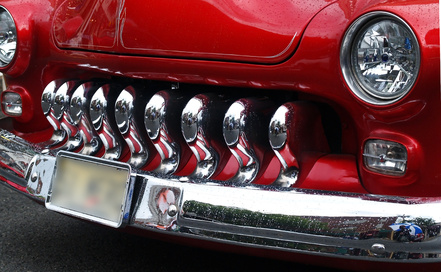
The paint on your car protects it from the elements as well as projectiles that are hurled at it as you travel down the road. When the protective covering on your vehicle begins to chip and flake away, it is time to remove that old coat and repaint your car. Painting a vehicle requires a dust-proof paint booth. But if you do not have a booth or the funds to rent one, a barrier box can be constructed to keep the dust out and give you a smooth, even paint job.
Push each end of every 20-foot PVC pipe into its own three-way coupling. Slide the ends of the 10-foot PVC pipes into the empty openings of the couplings to form a rectangular cube that measures 10 feet-by-10 feet-by-20 feet. Unroll your construction plastic. Cover five of the six sides of the PVC frame with plastic. Cut the plastic as needed with the razor knife. Attach the plastic to the pipes with duct tape. Attach the pieces of plastic together with duct tape to seal and complete your barrier box.
Load your palm sander with the heavy grit sandpaper. Sand every painted surface of the car to remove all of the paint from the vehicle in the process. Take your time, work from top to bottom and change the sandpaper in your sander as needed. Rinse away the dust and debris from your car with a water hose. Dry the entire car with soft, clean rags.
Lift the barrier box with the help of an assistant. Lower the barrier box over your car, making sure that the box is not touching any part of the vehicle. Cover the glass, wheels and any part that will not be painted with newspaper and painter’s tape. Use five layers of newspaper on every part. Trim the tape with your razor knife for an exact fit.
Load the reservoir cup on your spray gun with automotive primer. Spray a thin coat of primer onto every exposed surface of the car. Use short bursts with a side-to-side motion of your gun while holding the nozzle 15 inches from the surface. Allow three hours for the primer to dry. Apply a second coat of primer with the spray gun.
Clean your spray gun by filling the reservoir cup with paint thinner and shooting it into the empty bucket. Continue until the thinner hits the bucket with no trace of primer. Wipe the outside of the gun with a thinner-soaked rag. Let the primer dry overnight.
Rub the surfaces vigorously with newspaper to smooth the primer. Load your spray gun with automotive paint. Spray into the bucket until the paint runs pure and free of thinner. Apply three coats of paint to the car. Allow six hours of drying time between each coat of paint. Rub each coat of paint smooth with newspaper before the next application.
Clean your gun and load it with clear coat. Apply three coats of clear coat to the car, allowing each coat to dry for six hours before the next application. Remove the tape and newspaper 30 minutes after the final application of clear coat. Leave your car inside the barrier box for 24 hours before removing and disassembling the box.